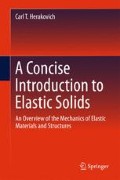Abstract
Torsion of cylindrical bars refers to the application of torque (twist) of equal magnitude at the opposite ends of a bar of cylindrical shape.
Access this chapter
Tax calculation will be finalised at checkout
Purchases are for personal use only
Author information
Authors and Affiliations
Corresponding author
Appendix: Solutions
Appendix: Solutions
-
7.6.1
Determine the polar moment of inertia of a circular bar radius R
Solution
-
7.6.2
What torque is required to twist an aluminum bar through an angle of 10° if the bar is 2 cm in diameter and 1.5 m long?
Solution
-
7.6.3
What is the maximum shear stress in Pa for the bar in Exercise 7.6.2?
Solution
-
7.6.4
What is the midlength shear strain at a radius r = 0.5 cm for the bar in Exercise 7.6.2?
Solution
-
7.6.5
Compare the maximum stress in steel, titanium, and aluminum bars for the parameters of Exercise 7.6.2
Solution
Now, \(\frac{\theta R}{L}\) is the same for all three bars. Thus,
Rights and permissions
Copyright information
© 2017 Springer International Publishing Switzerland
About this chapter
Cite this chapter
Herakovich, C.T. (2017). Torsion of Cylindrical Bars. In: A Concise Introduction to Elastic Solids. Springer, Cham. https://doi.org/10.1007/978-3-319-45602-7_7
Download citation
DOI: https://doi.org/10.1007/978-3-319-45602-7_7
Published:
Publisher Name: Springer, Cham
Print ISBN: 978-3-319-45601-0
Online ISBN: 978-3-319-45602-7
eBook Packages: EngineeringEngineering (R0)

